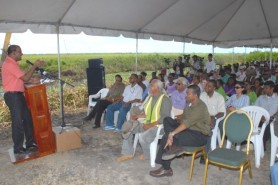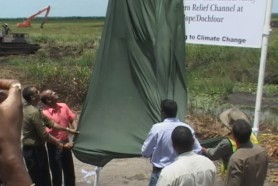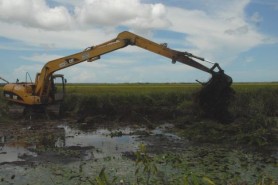Work on the Northern Relief channel of the East Demerara Water Conservancy (EDWC) to the Atlantic Ocean commenced yesterday at Hope/Dochfour with the authorities presenting it as a long-term solution in 24 months to flooding in the surrounding areas.
The official launch of the $3.6B project, which required the relocation of dozens of residents, coincided with Agriculture Month and with works being carried out at the back of the Mahaica area.
Works are being undertaken by the National Drainage and Irrigation Authority (NDIA) with assistance from the project consultants, CEMCO. SRKN Engineering and the UK-based Mott MacDonald company have jointly undertaken consultancy work with CEMCO. Another outlet from the EDWC assumed great urgency following the Great Flood of 2005 which was attributed in part to the conservancy.
At the southern end of the canal at the EDWC where work was on-going yesterday CEMCO lead consultant, Raymond Latchmansingh, while addressing a gathering which included President Bharrat Jagdeo, Minister of Agriculture Robert Persaud, and officials of the NDIA, stated that
the project began with the identification of a location at the EDWC to begin work and according to him poor weather conditions in the area were another impediment to initial consultancy works.


He said that having carried out the topographical survey, Mott McDonald was tasked with undertaking a hydrological survey of the project to determine flow, flood risks and overtopping in the area and he stated that the survey required a number of hydrological measurements as well as an inflow of rainfall data.
He said that the 10.3 Km long by 30m bed with canal leads through swampy areas and according to him the canal will utilize geo-textile soil strength features which is new to these shores but which is common in other parts of the world. Latchmansingh noted that the 30m bed width design will work in tandem with the embankment because the canal has to pass a public road and according to him a relief channel, which was discussed intensely, will carry an 8-door high level sluice which will affect water discharge at a high level.
The project, which is scheduled to be completed within the next two years, carries a budgeted $6.4M for consultancy, and according to NDIA CEO, Lionel Wordsworth, 14 long hand excavators were sourced by the government in December last year for the project. He said some 60% of the cost via contractors to use their equipment was saved in this regard.
He said that the engineering design of the 8-door discharge sluice and all drainage infrastructure for the project has been completed and will soon be tendered for.
Wordsworth stated that the NDIA is focusing on implementing and completing the project within the 24-month timeline and according to him the new relief channel will improve safety standards of the EDWC especially during periods of flood.
President Jagdeo, while addressing the gathering which included several farmers from the Mahaica/Mahaicony area, stated that the official commencement of works, “marks the beginning of a long term solution to a problem” which has affected the lives of many persons in the area during periods of flood.
He said he viewed the project as not only a technical solution to the problem of flooding but one which changes the lives of people who have suffered for decades.
He said many persons have questioned the economic feasibility of the project and that the government is going after something which is too expensive but he noted that, “no project can be too expensive when people’s lives are involved”.
He said that the citizenry need to see the links involved in the project adding that two things which stand out are, “for the first time we are creating a long term solution to the problem of flooding and it is being financed from our budgetary resources”.
The Head of State noted that he was pleased that the technical work on the project was undertaken thoroughly adding that when he made an initial announcement regarding the project, he was not too sure where it would have been financed from.

He also noted that the government is hoping to obtain assistance from the Japanese in strengthening the water conservancies adding that some $1B has been invested over the years in strengthening water management in the Mahaica/Mahaicony/Abary area.
Minister Persaud noted that the project saw not only the experts and technical teams being in the fundamental discussions but also the broader engineering community so that the project could have been studied, examined and re-examined. He said that he is confident that the 24-month completion timeline will bring tremendous benefits to the surrounding areas.
The $3.6 billion relief channel is intended to drain the EDWC into the Atlantic Ocean, serving as a more efficient and less destructive means of releasing water from the conservancy. At the moment, when the EDWC is at a dangerous level, water from the conservancy is drained through the Maduni and Lama sluices and this has caused catastrophic flooding in the Mahaica and Mahaicony areas.
There have been mixed views about the project, as several experienced engineers have opined that the construction of the channel is not the best option to drain the EDWC, since there are other cheaper and more effective options available. The Agriculture Minister, however, has repeatedly said that the decision to construct this canal is being done on the best technical advice.




